This post may contain affiliate links. Please read our disclosure for more info.
Symbols are a huge part of our lives whether we take notice of them or not, and in yoga they are very prevalent and hold a lot of meaning. Yoga symbols, like quotes, are an important part of human communication and are meant to convey a message, idea, concept, experience and/or spiritual belief in a visual form.
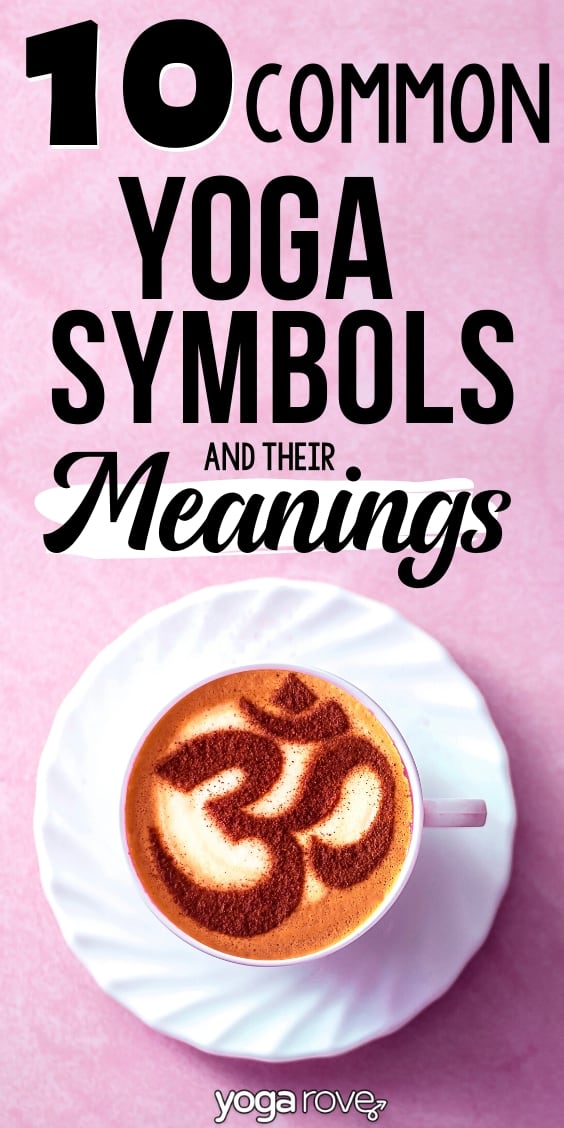
As humans, we try to find understanding and meaning in nearly everything we see and do and symbols help us do this. Yoga incorporates a lot of symbols to help us understand a deeper meaning behind everyday things. Depending on the culture using the yoga symbol, the meanings can be completely different.
We put together a list of the 10 most common yoga symbols used in yoga and explained their deeper meaning. Read on to learn more about these popular symbols.
Om
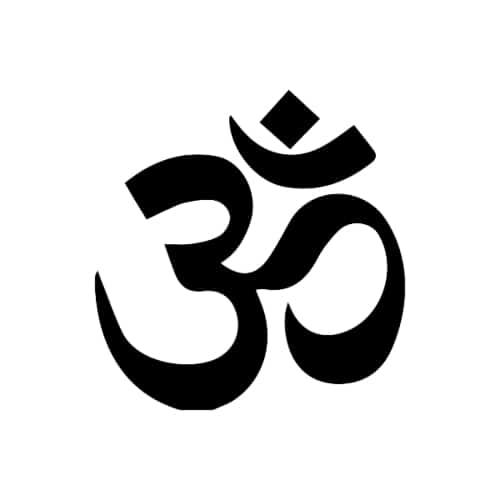
Also spelt “Ohm” or “Aum” this symbol represents the sound of the universe and can energize your chakras. Om is also considered a mantra. This chant unifies all words and sounds in the human language.
The sounds and vibrations created while chanting om can calm your mind and central nervous system and produce feelings of peace, tranquility and unity and will align your mind, body and soul. It can also reduce stress, improves concentration and can also support a healthy sleep cycle.
Each part of the Om symbol has a very specific meaning.
- The dot located at the top represents the Absolute State or the 4th state of consciousness. This state of consciousness is where you connect with the divine and experience absolute serenity and tranquility. The 4th state is the ultimate goal of spiritual awakening.
- The crescent shape directly below the dot represents illusion. This part represents anything that gets in the way of you and the absolute state. To the left is the crescent are two curves.
- The bottom represents the waking state and the top represents the unconscious state. The waking state curve is the largest of the curves because it is the most recognized state of consciousness. This is where we experience things with in the realm of the 5 senses.
- Above the waking state is the unconscious state, also known as the deep sleep state. We only reach this state of sleep when everything subconsciously stops, even dreams.
- Between these two curves is one last curve that signifies the dream state. The dream state is exactly what it sounds like. It is what we experience before the deep sleep and represents our dreams.
Lotus Flower
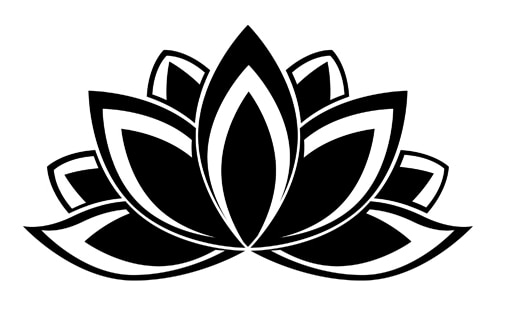
The Lotus Flower, also known as a Water Lily, is an important symbol in many cultures. There is a running theme within the Hindu, Buddhist and Egyptian cultures pertaining to the Lotus. This special flower rises from dark, muddy waters and blossoms into a gorgeous and alluring flower.
The really unique thing about this flower is the way it blossoms. The core of the flower and the pedals never touch the dirty water it grows in.
As a symbol this represents the human journey of rising above any adverse or unfortunate circumstances and into a self aware and spiritually enlightened human being.
Hindu Culture: Within the Hindu culture the Lotus specifically represents
- beauty – especially that of the female eyes, fertility, prosperity, spirituality and eternity.
- Certain gods like Laxmi – the god of prosperity and Brahma – the god of creation
- It is sometimes used as an offering to the Hindu gods as well as a part of Ayurveda medicine practices.
Buddhist Culture: The Buddhist culture uses the Lotus to symbolize
- purity
- spiritual awakening
- faithfulness
Buddhism really emphasizes purity due to the way the flower blossoms through the dark, dirty water unblemished. Buddhists put significance into the color of the flower, especially in paintings and other works of art.
- A blue lotus is typically representative of common sense and wisdom
- A white lotus is purity
- A purple lotus represents mysticism and the 8-fold path to Buddhism
- A pink lotus is the “true” lotus of Buddha
- A red lotus signifies the heart.
Egyptian Culture: Egyptian culture places a lot of significance on life after death and the lotus is very indicative of this.
Throughout Egyptian history the lotus represented rebirth and reincarnation. The Egyptians noticed how the flower disappears at night, only to reappear the next day – untarnished. They associated this with the rise and fall of the sun as well as life and death.
It is said that the Egyptian Book of the Dead has spells and rituals that help transform you into a lotus after you die. It is also thought that the lotus connected and bonded northern and southern Egypt and represented unity between the two.
The Lotus is important to many cultures and religions. It is a beautiful and perfect representation of our spiritual journey from darkness into the light.
Hamsa
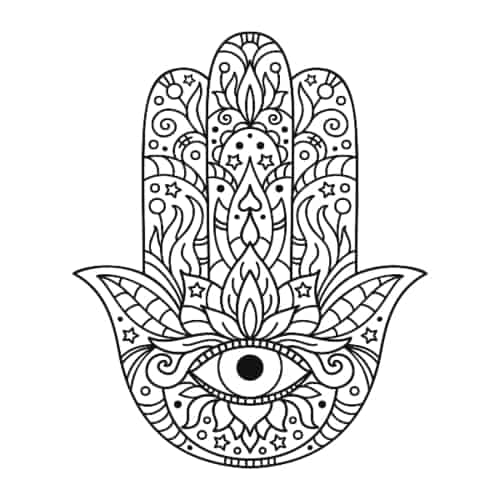
The Hamsa is an important symbol in many cultures and has several interpretations. It can typically be found as a piece of jewelry or in paintings and other artwork.They all have similar meanings but vary slightly. In general, the Hamsa stands for protection against the evil eye and is meant to bring health, wealth and fertility.
You will recognize the Hamsa as a hand with an eye in the center of the palm. It is always depicted as a hand with the 3 middle fingers extended. The way the thumb and pinky finger lay varies although, they will always be symmetrical and can have different meanings.
Most cultures use the Hamsa to evoke the hand of god and help to avoid negative influences. These interpretations are pretty universal and also represents purity, spiritual awakening and faithfulness.
In Jewish Culture: With in the Jewish culture, the Hamsa is heavily symbolic of the number 5.
- The 5 fingers represents the 5 books in the Torah and the five categories of sacrifices and offerings talked about in the Torah which comprise of burnt, sin, trespass, grain, and peace.
- There is also the five parts of the human soul: physical, emotional, intellectual, spiritual and God.
- Another correlation with the number 5 and God is that the 5th letter of the Hebrew alphabet is Het which is also one of God’s holy names.
In Buddhist and Hindu Culture: In Buddhism and Hinduism, the five fingers are symbolic of the chakras and the 5 natural elements.
- The pinky finger represents the sacral chakra and the water element.
- The thumb represents the solar plexus and the fire element.
- The middle finger is a representation of the throat chakra and the celestial elements.
- The forefinger symbolizes the heart chakra with the air element.
- The ring finger is a symbol of the root chakra and the earth element.
Mandala
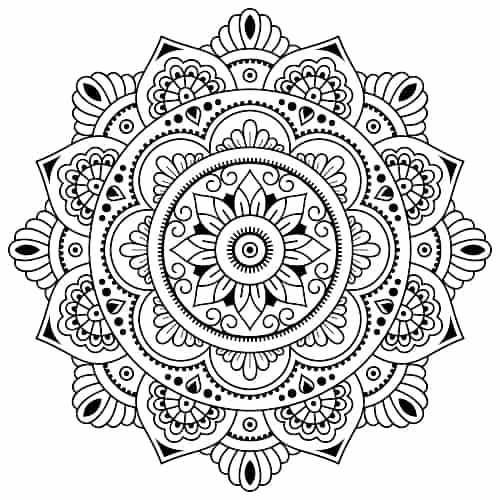
In Sanskrit, mandala means “circle” and is a direct note to the never ending circle of life and is meant to serve as a tool on your spiritual journey through this life. A mandala is typically used as a tool for meditation to help reveal someone’s path in life or to tell a story of where someone has already been. There are two main ways to use a mandala for meditation.
- As a piece of artwork or photo you can focus on a mandala and follow the designs, patterns and shapes. As you do this, your thoughts will calm down and allow you to understand the journey you have already been on or to show you guidance for a future journey.
- Creating your own mandala drawing or coloring in a blank image has been a super popular activity in recent years because of its calming and relaxing benefits.
All mandalas are visually appealing and alluring. Colors used in mandalas also serve a purpose.
- Red = strength
- Pink = love, femininity
- Orange = creativity, transformation, self- awareness, intuition
- Yellow = learning, wisdom, laughter, happiness
- Green = physical healing, physical ability, love of nature
- Blue = emotional healing, inner peace, meditation
- Purple = anything spiritual
- Black = mystery, deep thinking, individuality
Mandalas represent wholeness, unity and harmony. They should always be symmetrical with radial balance. They should also always be intriguing and draw a person into them, especially using numerous and vibrant colors.
Buddha
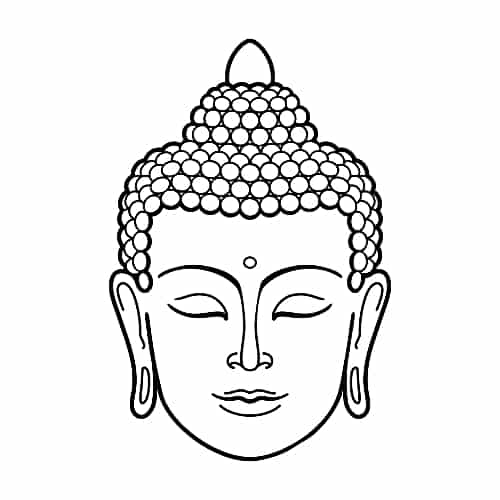
The image of Buddha is one of the most recognized symbols in the yoga world. The original Buddha was called Siddartha Gautama before his enlightenment meditation under the fig tree, which is still a sacred and protected site.
Today, Buddha, or the image of Buddha, represents someone who has attained “Bodhi” and thus can be a spiritual guide for others. Bodhi is the ideal state of intellectual and ethical perfection.
Buddha is also called the enlightened one who knows everything – past, present and future and has been awakened from ignorance to see things from an unbiased perception.
Someone who can be called Buddha
- Has unbounded compassion
- Is completely impartial
- Non judgmental and does not discriminate
- Loves all living beings
- Has wisdom and power
- Is charitable
- Has high morals and self control
- Is honest and generous
- Is patient
- Is hard to anger and is non violent
The Buddha is an important symbol for many people. It can remind you of the 3 tenants of Buddhism which are not to be ignorant, not to hate others and not to get angry. Buddha can also remind you to practice moderation. His last words to his followers were, “All component things in the world are changeable. They are not lasting. Work hard to gain your own salvation.”
The Number 108
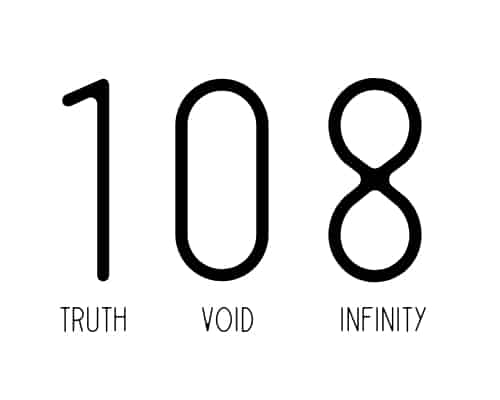
In most religions around the world, past and present, the number 108 holds some sort of sacred significance.
The number represents wholeness, spiritual completeness and signifies the basis of all creation. The number 108 is also important in the yogic traditions and shows up in nature, science and ancient architecture. There are numerous examples of “108” popping up.
- The distance between the Earth and the Sun is 108 times the diameter of the Sun
- The distance between the Earth and Moon is 108 times the diameter of the Moon
- The diameter of the Sun is 108 times the diameter of the Earth
- There are 108 sacred sites in India
- There are 108 pressure points in the human body
- 108 energy lines that come together to form the heart chakra.
- We have 108 different types of feeling, 36 in the past, 36 in the present and 36 in the future.
- When making malas, garland or prayer beads, 108 is the number of beads used
- Stonehenge is 108 feet in diameter
- The High Temple of Lamanai, in Belize, is 108 feet tall
- The Tikal Temple in Guatemala is also 108 feet tall
- The Hindu religion has 108 different names for gods
- In Jainism there are 108 virtues.
- 108 is known as a Harshad Number which means it is divisible by the sum of its numbers 1+0+8=9 and 108 is divisible by 9 and in Sanskrit, “harshad” means joy
- In Sanskrit there are 54 letters and each letter has 2 forms – masculine and feminine and 54×2=108
- There are 108 forms of meditation and 108 paths to God
- There are 108 Tibetan Holy Books
Mala Beads
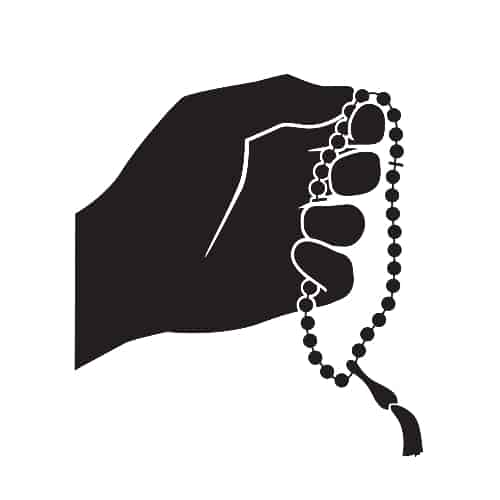
Mala Beads are used during meditation, much like the rosary. In Sanskrit the word “mala” literally translates to meditation garland. Malas typically feature 108 beads and one Guru Bead.
The Guru bead is always bigger than the rest and represents a spiritual guide. It is also used as a place maker for the beginning and end of your meditation. It can signify the relationship between a spiritual guide and their student.
During meditation the rest of the beads help you keep track of how many times you say a prayer or mantra. Each time you repeat the mantra you move your hand to the next bead. Often times, malas also feature a tassel and it represents a connection between you and God, as well as you and others.
Malas can be made out of numerous different materials and colors of beads and they each have different meanings.
- Red Jasper – Grounding, organization, creativity, empathy, rejuvenation, mental clarity and focus.
- Red Tiger Eye – Motivation, protection, perception, humbleness, confidence. I
- Garnet – Cleansing and energizing, self-confidence.
- Rose Quartz – Truth, harmony, unconditional love.
- Rhodonite – balancing and healing
- Unakite – Grounding and balancing.
- Carnelian – creativity, motivation, vitality, courage,
- Amber – Healing, cleansing, vitality, stress relief, emotional healing.
- Goldstone – Generates energy and protection.
- Citrine – energy and prosperity.
- Yellow Malay Jade – wisdom, moderation, and perspective.
- Honey Calcite – energy, vitality, confidence, strength, and persistence
- Green Aventurine – Compassion, empathy, perseverance, prosperity, decisiveness.
- Moss Agate – self-esteem, personal growth, inspiration, optimism
- Green Jade – calming and relaxing
- Malachite – Creativity, confidence, emotional balance.
- Blue Aventurine – communication and creativity
- Blue Tiger Eye – stress relief, motivation, protection, perception, humbleness and confidence.
- Indian Bloodstone – Healing, detoxifying, revitalizing.
- Lapis Lazuli – inner truth, self-awareness, and self-expression.
- Blue Sky Jasper – Protection
- Amethyst – Memory enhancer, motivator, tranquilizer. Protective. Balancing.
- Crazy Lace Agate – Calming, self-acceptance and self-confidence, concentration and focus.
- Sugilite – Protects and removes negative attachments.
- Smoky Quartz – Relieves stress while promoting serenity and strength
- Black Agarwood Eaglewood – Invigorates, purifies, calms.
- Obsidian – clarity, stabilizing, insightful, compassion, and strength.
- Black Onyx – Protection, strength, good fortune, vigor and health.
- White Howlite – memory, patience, calm, positive.
- Mother of Pearl – Healing, protecting, creative
- Clear Quartz – healing, cleansing
- Pearl – grace, purity, truth, happiness, compassion, and integrity.
- Bodhi Seed – Awakening. Spiritual promise, dedication, faith.
- Bayong Wood – stability, spiritually
- Tiger Eye – Protection and grounding, confidence,
- Brown Agate – inner stability, self-confidence, composure, and maturity, concentration, perception
- Tulsi – cleansing, provides protection.
- Rosewood – protection
Ganesh
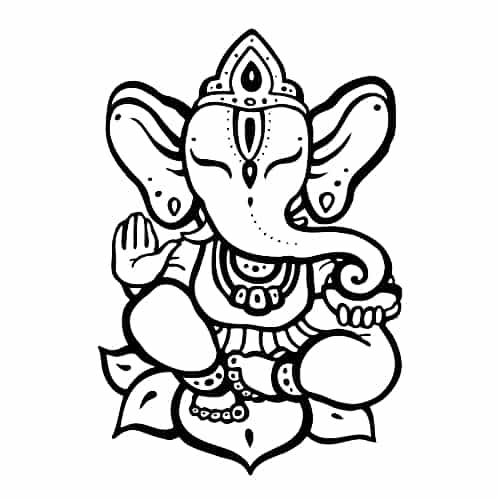
Ganesh is a Hindu god who is always depicted with the head of and elephant and is associated with the first chakra. He is known as the Lord of Good Fortune and the Lord of Beginnings. He provides prosperity, fortune and success while removing both spiritual and material obstacles. The different parts of Ganesh also hold symbolic meaning.
- His big elephant head is a representation of knowledge and wisdom and reminds us to “think big”
- His small eyes remind us to focus and enjoy the small things in life.
- Ganesh’s small mouth reminds us to talk less and to embrace silence
- His big ears remind us to listen more
- The trunk is meant to symbolize versatility and adaptability
- Ganesh is usually depicted with only one tusk and this is to remind us to remember the good and forget the bad
Ganesh can also grant wisdom and knowledge.
Namaste
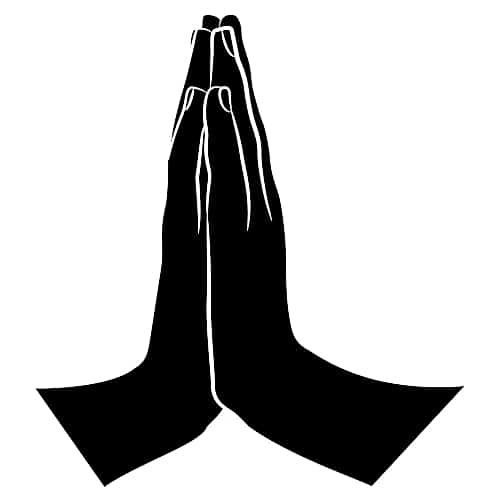
Typically heard at the beginning and/or end of a yoga or meditation class, Namaste translates to “the light in me honors and acknowledges the light in you.” The word ‘light’ meaning soul or the divine. We say this to let each other know that we see them and share in their spiritual and/or yogic journey.
When you are using the namaste greeting, bring your palms together at heart center and bow as you say “namaste”. It also represents gratitude, connection and respect towards each other.
In Sanskrit, Namaste can be broken down into “nama” meaning bow, “as” meaning I and “te” meaning you and together means I bow to you.
When saying Namaste, most people bring their palms together at heart center, representing the heart chakra or by bringing your your palms first to forehead center representing the third eye chakra.
At the very least, namaste is an acknowledgment of being equals. However, to others it has a deeper, more spiritual level.
Chakras
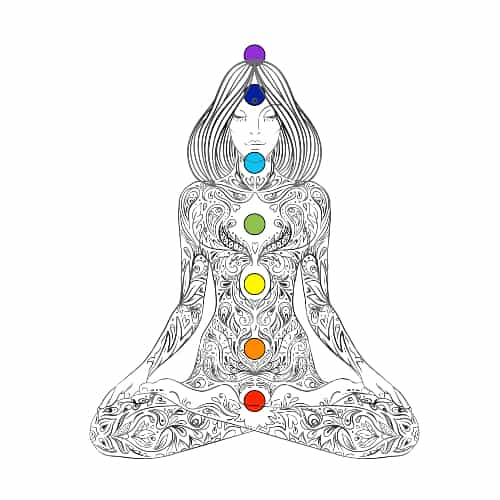
Chakras are points along the spinal column, beginning at the base of the spine and ending at the crown of the skull, they are believed to be spots that energy flows through.
The word chakra literally means “wheel or disk” and it describes the spinning energy life forces throughout various points in the body.
A chakra can be deficient, excessive, or both. An excessive chakra needs to discharge energy and a deficient chakra needs to receive energy.
Things like childhood trauma and abuse, cultural upbringing, restrictive and exhausting habits or beliefs, physical or emotional injuries and the loss of basic human rights can all effect and block chakras. When all the chakras are functioning correctly we feel balanced because chakras link our mind, body.
- The Root Chakra is located at the base of the spine near the tailbone area.
- Earth element and is associated with the color red.
- It represents our basic right as a human to be here on earth – it is our physical identity (self preservation) and our foundation.
- It is the chakra that helps us feel grounded. When this chakra is balanced you will be in good health and well grounded. You will feel safe and secure and be able to relax. You will be comfortable with your body with the ability to relax and prosper.
- If you are deficient in this chakra you may feel disconnected from your body, underweight, fearful and anxious, restless, unable to focus, disorganized and poor boundaries.
- The Sacral Chakra is located in the lower abdomen, below your belly button.
- It is the water element and associated with the color orange.
- It is our emotional and sexual identity (self-gratification) which represents our basic right to be able to feel – especially pleasure. It also allows you to connect to others and new experiences.
- When balanced you should experience graceful movements, emotional and spiritual intelligence, healthy boundaries and the ability to accept change. An excess of energy in the Sacral Chakra could look like sexual acting out or addiction, overly strong emotions and poor boundaries, over sensitive and emotionally dependent and manipulative in a sexual nature.
- If deficient you may have poor social skills and fear change. There could be a lack of desire, passion and/or excitement as well as a fear of sex or pleasure.
- The Solar Plexus Chakra is located in the upper abdomen.
- It is the fire element and shows up as the color yellow.
- The right to act is the basic human right associated with this chakra and coincides with the ego identity (self -definition) and transformation and the right to be an individual.
- When balanced you are reliable and responsible. You have appropriate self-esteem and confidence. You are spontaneous and playful with a good sense of humor. You have self-discipline and are able to meet and overcome challenges.
- When you are deficient in this chakra you may have low energy and low self-esteem which could create an addiction to stimulants. You could be cold emotionally and physically and be unreliable. You may be passive and play the victim role and blame others as well as be easily manipulated by others.
- The Heart Chakra is located in the center of the chest just above your heart.
- It correlates with the air element and the color green.
- It represents the basic right to love and be loved as well as your social identity (self- acceptance).
- When it is functioning properly you should feel compassionate, loving and empathetic.
- When the chakra is deficient you could be feeling antisocial, depressed, judgmental and lonely. You could be afraid of intimacy and relationships.
- The Throat Chakra is located in the throat.
- It is associated with the element of sound and the color blue.
- It represents the right to speak and hear the truth, this is also representative of your creative identity or self -expression.
- When your throat chakra is in balance you should show characteristics of a good listener and a good communicator.
- If you are lacking energy in this chakra you could have a fear of speaking or having difficulty expressing yourself verbally.
- The Third Eye Chakra is located between the eyes.
- It is represented by the element of light and the color indigo.
- It is associated with the archetypal identity and self- reflection.
- It represents the basic human right to see or to be seen.
- When is balanced you will be instinctive and perceptive as well as imaginative with a good memory.
- If you are deficient in this chakra you could have poor vision and memory, you could have a lack of imagination and difficulty visualizing things.
- The Crown Chakra is located at the very top of your head.
- It is connected to the element of thought and the color violet.
- It is associated with the right to know and the right to learn.
- When you are balanced in this chakra you have the ability to perceive and analyze situations and data. You are intelligent and wise as well as thoughtful and open minded.
- When you are lacking energy in this chakra you may have trouble learning and have a rigid belief system.
These symbols are meaningful and important to yoga culture. They have been around for hundreds if not thousands of years connecting practitioners to spiritual enlightenment, guidance and meaning in this life. Symbols are something that carry meaning throughout many generations. Symbols can be personal and universal and mean different things to different people but they help us all understand things on a different level. They help us to share important meanings with each other.
Which symbol(s) do you connect with the most?







Sorry, in advance, for such a weird Comment but it’s a compliment..! 🥴😜Great article! Love the detailed description of each symbol. The wording you used to describe the symbols and each element within each symbol is very well written and laid-out which makes it super easy to understand and comprehend. I like how you gave very direct(yet thorough) definitions of each symbol and gave perfect descriptions of the various cultural and religious translations without making it complicated. A lot of articles get waaay too “wordy” and detail-oriented within one or all bullet points of discussion that it becomes too overwhelming to comprehend it all…. it’s like they are bouncing all over the place with no solid focus or direction. It’s too much info and too broad of a spectrum to cover in one article but they do it anyways… I have read hundreds of articles on these symbols and similar and I have to say, this one has probably been one of the most effective ones when it comes to me comprehending the entirety. Thank you!
So glad you found it helpful Lauren!
I found this explanation absolutely wonderful. I will reread it many times & learn it well. Thank you.
Glad you found it helpful Jenny!
Wonderful article. I’m saving it to print out, as you’ve explained it also beautifully.🕉️🙏
So glad you found it helpful Pam! 🙂
I have always been interested in what I will call the movements of yoga without understanding much about the practice or symbols. This article gave a deeper understanding and clearly explained the symbols. Importantly as well you cleared up some of the misconceptions presented over the years about the practice of yoga.
So glad you found it helpful Diana!